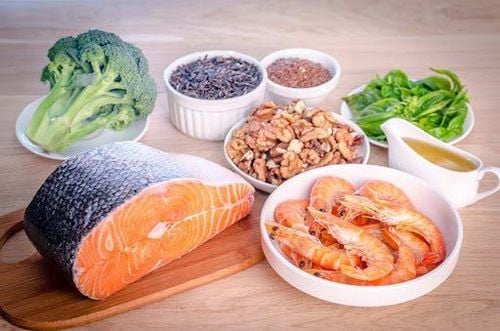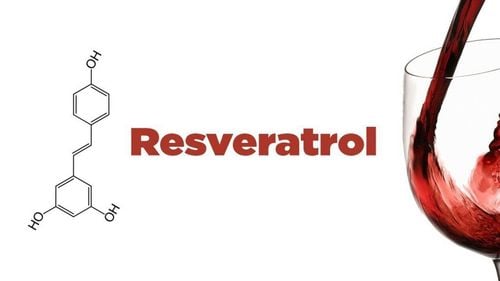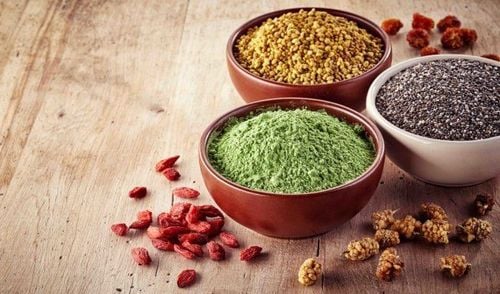This is an automatically translated article.
Most people are afraid that the shell of food contains preservatives, so they usually remove it when eating. Paradoxically, in some foods, the skin is richer in nutrients than the gut. The article will provide readers with some foods with shells rich in nutrients and very good for health.
1. Shrimp Referring to food that eats the shell, many people will immediately think of shrimp. Some people think that shellfish contains a lot of calcium, so it is good for bones and joints. But in fact shrimp shells contain very little calcium. However, that does not mean that they are not beneficial. Shrimp shells are rich in chitin, a substance that has the ability to reduce cholesterol and limit obesity. In addition, the inside of shrimp shells also contains chitosan - an ingredient that has the ability to improve blood pressure. In particular, chitosan has the ability to block fat absorption and create a feeling of fullness, limiting appetite for overweight and obese people.
2. Eggplant Eggplant skins are high in antioxidants. In particular, the darker the tomato, the richer it is in antioxidants. Therefore, eggplant varieties will have more nutrients in the skin than white varieties. You can feel the skin of the eggplant a bit tough. Try roasting eggplant with the skin on and enjoy, you won't be disappointed.
3. Peach The outer skin of a peach is packed with antioxidants and vitamins. Not only that, it also has a lot of fiber. As a result, eating peach peels can help reduce the risk of cataracts. You'll also get a good dose of fiber, which aids digestion and prevents constipation.
4. Potatoes Potatoes are indispensable when it comes to whole foods. Many people often peel potatoes and eat only the insides. But actually the skin of the potato contains a lot of fiber and nutrients like vitamin B, vitamin C, potassium, calcium and iron.
5. Watermelon Watermelon rind has an amino acid called citrulline. It can help remove nitrogen from the blood and can also help relieve pain if you have muscle pain. In fact, the rind has more citrulline than the succulent flesh. If you don't want to eat the skins raw, there are other ways to prepare them. You can soak, squeeze the watermelon rind to get juice or stir-fry as a vegetable.

Đào là một trong các thực phẩm ăn cả vỏ
6. Apple Apple peel is certainly no stranger to believers who like to eat food peels. The peel of an apple contains more vitamins and fiber than the inside of the fruit. The fiber in the peel is useful to prevent the accumulation of cholesterol in the blood vessels. In addition, apple skin has an antioxidant called quercetin that can help your brain and lungs function better.
7. Cucumber Most of a cucumber's nutrients are in its dark green skin. Potassium, antioxidants and fiber are the main ingredients in cucumber skin. At the same time, cucumber skin is also rich in vitamin K, an essential ingredient that helps support bones and blood clotting. But if the cucumber you're eating isn't organic and it's covered in a thick layer of wax, you should peel it off and eat only the insides.
8. Mango Poison ivy has a chemical called urushiol. It's what causes the itchy rash for most people who come into contact with ivy. Mango peels also contain that chemical. If you don't have a poison ivy rash, don't skip the mango peel. The skin of a mango is full of fiber and is high in vitamin E, vitamin C, antioxidants, polyphenols, and carotenoids. In addition, it also has polyunsaturated fatty acids and also omega-3, omega-6.

Vỏ quả kiwi rất giàu chất chống oxy hóa, flavonoid và vitamin C
9. Kiwi Kiwi has a slightly chewy skin and contains a lot of hair. But don't let the appearance of the kiwi fruit's rind stop you from enjoying it. If you're still apprehensive, you can shave off the kiwi's fluff. The skin of the kiwi fruit is rich in antioxidants, flavonoids and vitamin C. In fact, the kiwi skin has more nutrients than the flesh inside.
10. Zucchini The rind of a zucchini can taste a bit bitter but is extremely nutritious. You'll get fiber, potassium, and some vitamin C when you eat zucchini skins. In addition, it is also rich in antioxidants such as lutein, carotenoids and zeaxanthin. You can easily turn zucchini with the skin on into delicious side dishes like salads, soups or stir-fries.
11. Banana Bananas have a tough skin and taste bitter when eaten. However, banana peels have some amazing health benefits. It has potassium and antioxidants like lutein. Lutein is great for eye health. Banana peels also have an ingredient called tryptophan, an amino acid. Because the peel is tough and has a bitter taste, you can boil it for a few minutes, then put it in the oven to dry and then use it as a tea or smoothie.
12. Oranges Orange peels have an incredible amount of vitamin C - twice the amount of vitamin C in the fruit. They are also high in vitamin B6, calcium, potassium, magnesium, and riboflavin (a type of B vitamin). Orange peels are difficult to digest and can be bitter. So use a grater to break up the orange peels. You can use chopped orange peels to mix salads. The taste of orange peel also goes well with chocolate and ice cream.
However, with the current state of food hygiene and safety, it is not safe to eat the whole skin of some vegetables and fruits, even potentially harmful because they may contain preservatives. plant protection, preservatives... It is important that you choose to buy foods with clear origin and proven safety. Be careful with any food you are using whether you eat the peel or not to ensure the health of yourself and your family.
Please dial HOTLINE for more information or register for an appointment HERE. Download MyVinmec app to make appointments faster and to manage your bookings easily.
Reference source: webmd













